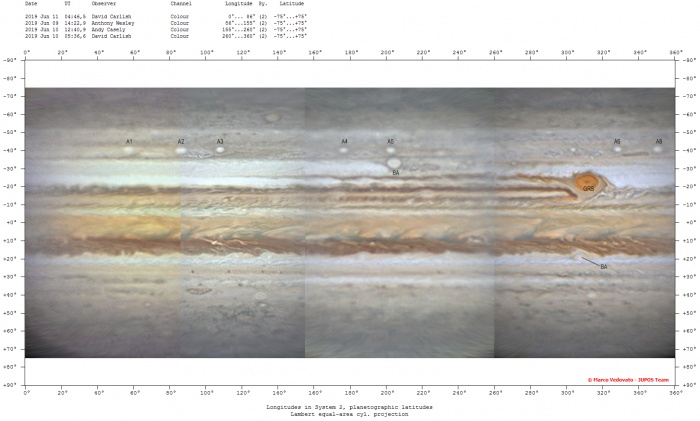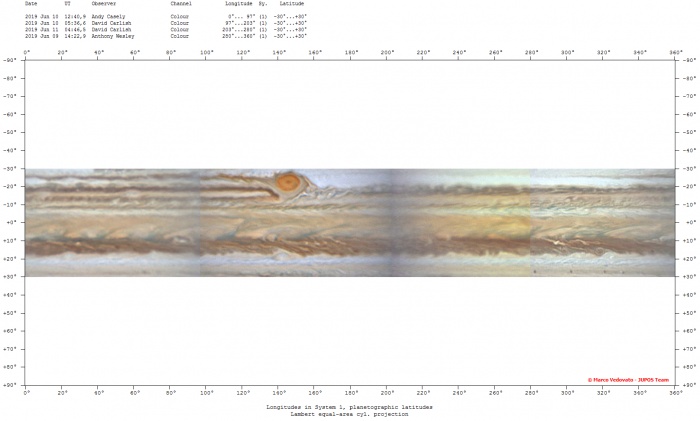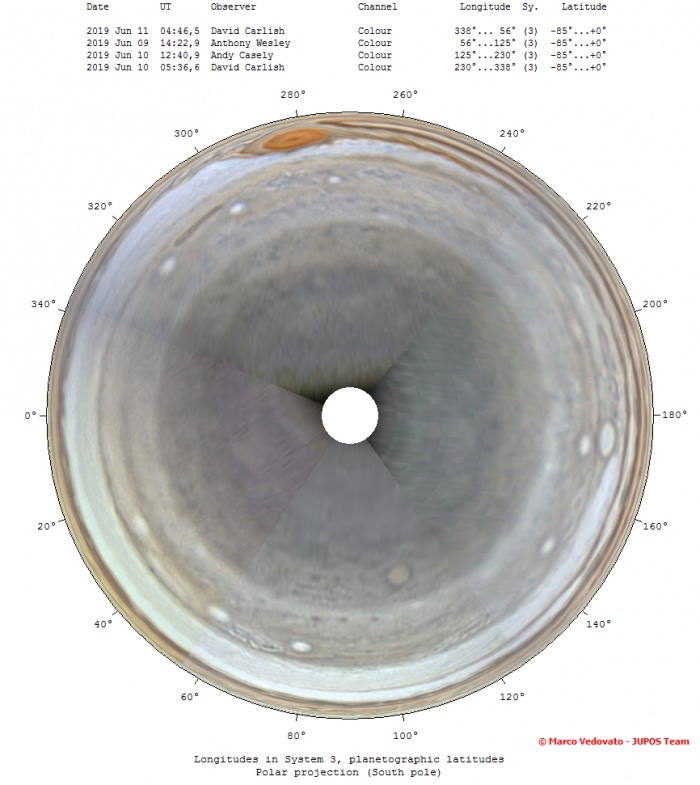Giove: mappa più recente
Da Sezione Pianeti UAI.
| (293 revisioni intermedie non mostrate.) | |||
| Riga 1: | Riga 1: | ||
| - | + | '''JUPITER: LATEST PLANISPHERES''' | |
| - | ''' | + | <br>'''Jupiter planispheres composed with images taken on 2019 June, 09-11''' |
| - | [ | + | <br> Maps prepared by Marco Vedovato with the software [http://jupos.org/ WinJUPOS]. |
| - | + | ||
| - | + | ||
| - | + | ||
| + | '''λ3 SYSTEM MAP (equirectangular projection, zenographic latitudes, North up)''' | ||
| + | [[Image:J Map L3 201906_09-11.jpg|thumb|center|980px]] | ||
| - | + | '''λ2 SYSTEM MAP (equirectangular projection, South up)''' | |
| + | [[Image:J Map L2 201906_09-11.jpg|thumb|center|700px]] | ||
| - | + | '''λ2 SYSTEM MAP + LABELS (equirectangular projection, South up)''' | |
| + | [[Image:J Map L2 201906_09-11_labelled.jpg|thumb|center|700px]] | ||
| - | + | '''λ1 SYSTEM MAP (equirectangular projection, South up)''' | |
| + | [[Image:J Map L1 201906_09-11.jpg|thumb|center|700px]] | ||
| - | '' | + | '''λ3 SOUTHERN POLAR MAP''' |
| + | [[Image:J Map South L3 201906_09-11.jpg|thumb|center|700px]] | ||
| - | '' | + | '''λ3 NORTHERN POLAR MAP''' |
| + | [[Image:J Map North L3 201906_09-11.jpg|thumb|center|700px]] | ||
| - | + | === Remarks about some visible features === | |
| - | '' | + | ''SSTB Ovals'' - White spots at 40,5°S, long-lived anticyclonic eddies named A1, A2, A3 ... Their drift rates bring them to overtake the GRS about once a year. |
| - | '' | + | ''BA Oval'' - It results from the merging of three pre-existing ovals in 2000. It is a large anticyclonic eddy, close to latitude 33°S; in 2005 its color turned to a pale red. Its drift rate causes BA to overtake the GRS about every two years. |
| - | '' | + | ''STrB'' (South Tropical Belt)- Color intensity and latitude of this belt vary according to longitude. |
| + | ''GRS (Great Red Spot)'' - Its border is sometimes marked by a dark ring; the inner region is currently pale red. Its size is gradually shrinking. | ||
| - | '' | + | ''SEB'' (South Equatorial Belt)- This belt disappears periodically; each disappearance is followed by an outbreak that restores its usual activity. Actually there is, on the southern border, a large disturbance, known as "South Tropicakl Disturbance" (STrD). |
| - | |||
| - | * [[Giove|Visita la Sezione Giove]] | + | ''EB'' (Equatorial Belt)- Sometimes a faint belt develops in the Equatorial Zone. After its formation the belt slowly fades away, only to reappear during the periods of most intense activity of the planet. |
| + | |||
| + | ''NEB'' (North Equatorial Belt) - This belt is the darkest on the planet, active both along the edges and in its inner regions. About every four years it expands northward, and then it shrinks back. This phenomenon entails the production of white ovals and dark spots along the broadening edge. | ||
| + | |||
| + | ''WSZ (White Spot Z)'' - This spot formed in 1997, as one of many (anticyclonic) white spots at latitude 19°N. A long-lived spot, characterized by a fast prograde drift that brings this spot to interact with other ones sharing the same latitude, but that are usually stationary in System II. In November 2013 its color turned to a light reddish hue. | ||
| + | |||
| + | ''NTrB'' (North Tropical Belt) - It undergoes periodical outbreaks of white spots and dark condensations that produce veils in the neighboring zone (NTZ), in the same manner as SEB and NEB. | ||
| + | |||
| + | ''NNTB'' (North-North Temperate Belt) - Its appearance changes with longitude, with some more noticeable dark streaks. | ||
| + | |||
| + | ''LRS'' (Little Red Spot) in NNTZ - Hardly conspicuous, but long-lived feature. Placed at latitude 40°N, it formed as early as 1993. Periodically, its red color becomes more intense. | ||
| + | |||
| + | <br> | ||
| + | |||
| + | *[[Giove|Visita la Sezione Giove]] | ||
Versione corrente delle 13:04, 12 giu 2019
JUPITER: LATEST PLANISPHERES
Jupiter planispheres composed with images taken on 2019 June, 09-11
Maps prepared by Marco Vedovato with the software WinJUPOS.
λ3 SYSTEM MAP (equirectangular projection, zenographic latitudes, North up)
λ2 SYSTEM MAP (equirectangular projection, South up)
λ2 SYSTEM MAP + LABELS (equirectangular projection, South up)
λ1 SYSTEM MAP (equirectangular projection, South up)
λ3 SOUTHERN POLAR MAP
λ3 NORTHERN POLAR MAP
Remarks about some visible features
SSTB Ovals - White spots at 40,5°S, long-lived anticyclonic eddies named A1, A2, A3 ... Their drift rates bring them to overtake the GRS about once a year.
BA Oval - It results from the merging of three pre-existing ovals in 2000. It is a large anticyclonic eddy, close to latitude 33°S; in 2005 its color turned to a pale red. Its drift rate causes BA to overtake the GRS about every two years.
STrB (South Tropical Belt)- Color intensity and latitude of this belt vary according to longitude. GRS (Great Red Spot) - Its border is sometimes marked by a dark ring; the inner region is currently pale red. Its size is gradually shrinking.
SEB (South Equatorial Belt)- This belt disappears periodically; each disappearance is followed by an outbreak that restores its usual activity. Actually there is, on the southern border, a large disturbance, known as "South Tropicakl Disturbance" (STrD).
EB (Equatorial Belt)- Sometimes a faint belt develops in the Equatorial Zone. After its formation the belt slowly fades away, only to reappear during the periods of most intense activity of the planet.
NEB (North Equatorial Belt) - This belt is the darkest on the planet, active both along the edges and in its inner regions. About every four years it expands northward, and then it shrinks back. This phenomenon entails the production of white ovals and dark spots along the broadening edge.
WSZ (White Spot Z) - This spot formed in 1997, as one of many (anticyclonic) white spots at latitude 19°N. A long-lived spot, characterized by a fast prograde drift that brings this spot to interact with other ones sharing the same latitude, but that are usually stationary in System II. In November 2013 its color turned to a light reddish hue.
NTrB (North Tropical Belt) - It undergoes periodical outbreaks of white spots and dark condensations that produce veils in the neighboring zone (NTZ), in the same manner as SEB and NEB.
NNTB (North-North Temperate Belt) - Its appearance changes with longitude, with some more noticeable dark streaks.
LRS (Little Red Spot) in NNTZ - Hardly conspicuous, but long-lived feature. Placed at latitude 40°N, it formed as early as 1993. Periodically, its red color becomes more intense.






